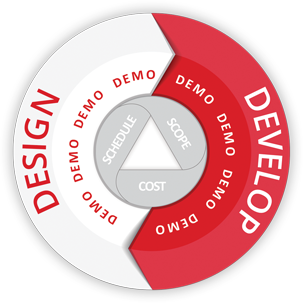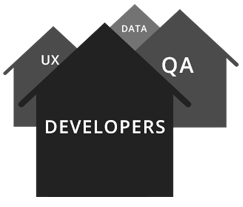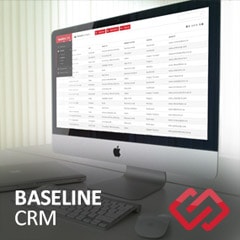Why Is Software Development So Expensive?

A conversation that many business owners have with their software development team is about the cost of software development and how it can be somewhat startling. Many businesses tend to underestimate the time and financial resources required to build quality, functional software applications. In reality, more goes into software development than you might think. Software requires an in-depth understanding of business processes combined with a variety of skilled individuals working together. Here are a few of the components of a development project.
Business Analysis
The first step to every development project is business analysis. Developers need to understand your specific workflows before they can actually start developing. Every business is different – some businesses have similar workflows, but almost every circumstance has unique requests. The business analysis works as the blueprint for your software and involves a commitment from both yourself and your development team. Every dollar that is spent during the business analysis phase comes back to you during the actual development phase.
Database Development
Next is the information management component. Both internal and external data needs to be managed. If businesses lack modern databases, then those need to be created.
Data Analysis
Developers need to ensure your data is being pulled correctly and transferred into usable results. Data analysis involves advanced mathematical, and in some cases scientific, calculations that drive business processes and decisions.

Research
Whenever software is developed, industry analysis must occur. If a software development team has never worked in the medical industry, but need to develop a system for nursing and medical information, then extensive research needs to be completed before they can completely dive in. Every industry has their own jargon, processes, standards and preferences that need to be considered.
UI/UX Design
Once a framework for a software system has been agreed upon, there needs to be time allocated to both user interface (UI) and user experience (UX) design work. It is important that each client has a design that speaks to their business specifically. The design of a system must be both intuitive and visually appealing. The experience must be crisp and simple enough for everyone to utilize the new system without extensive training. This stage usually involves multiple mock-ups and prototypes.
Development Phase

Once business processes, information management and UI/UX design have been agreed upon by all involved parties, the “real” development begins. The complexity of your system will determine your total projected development time. Also, you will need to determine which development process your development team uses. Each process has their own pros and cons, can take more or less time, and involve extended or concentrated time commitments from the client.
QA Testing
Testing or Quality Assurance (QA) is critically important during development. QA is the aspirin – they relieve all of your headaches. QA constantly tests your custom software and ensures that everything is working correctly and they offer recommendations on how to make the experience better for your users.
Deployment
Software needs to run in an environment. This may mean your servers host the system or the development team hosts it for you. This system must be accessible and optimized on whichever specific environment fits your specific needs. If deployed on a new environment, tests will need to be run in order to ensure complete compatibility.

Training
You are now at the training stage – you are nearing the home stretch. Members of your development team will help train your staff or train your trainers that will in turn train your staff. Training may be a few afternoons over video chat or maybe it is a few days of in-class training. This is completely dependent on your software complexity and the workflows that you have had developed.
Post-Implementation Support
Congratulations, your software has been completed! Moving forward, your client-development team relationship continues. Support is vital for custom software and in building post-implementation relationships with clients. Support is usually phone-based and involves multiple levels of escalation. Post-implementation can be small bug fixes, additional feature development or more staff training. Businesses often overlook post-implementation. Post-implementation is not seen as an additional expense, but an additional investment into your software solution. Custom software is never deployed and then left alone – it is an ongoing process where both parties involved reap the benefits.
Changing Requirements
There may be a handful, but not many development projects stick 100% to their original blueprint. Features or workflows are discovered or uncovered and cause adjusted projections. It is bound to happen, but when it comes to software development, finding new features or bugs is not a bad thing. To mitigate the costs of changing requirements, you should have pre-planned alternate routes or software detours. These routes should have tiered off-ramps that allow you to save money and ensure your key features are included.
Why Software is So Expensive - Conclusion

Overall, the costs come from not just the development team, but the efforts of the designers, QA, data analysts and many others. The simple reason that software development is so expensive is because it takes a village to develop good software. For people and organizations that think custom software development is as simple as calling up their local software developers and asking for a system, you have overlooked the importance of the process.
The best software and the happiest customers are not created during the development process, but the planning process. The more an organization gives in terms of communication, the more the software solution will facilitate their specific needs and the more value they will receive. Software development involves research and feedback. It is a give and take relationship that goes much beyond purely transactional. A good development team sits down with their client and finds out what it is exactly that they need. Every business is unique and the processes that they go through on a day-to-day basis are ever-changing. This is why custom software is so expensive.
If this conversation speaks to you, don’t worry – you are not alone. The true benefits and value of custom software are often overlooked. Software development is not just lines of code. Software development is a partnership between a business and a developer that leads to improved processes and overall satisfaction. If a business wants to complete a specific goal, than off-the-shelf is a good choice. However, if your business wants a tailored solution, than custom development is a route you will want to consider.
Every business is unique and so is the software they need. Get your free Personal Needs Analysis today.
And as always, Thanks for Reading!
Steve Malott







Comments